Pagan Gods
Поганські Боги
Pagan Gods
Поганські Боги


To understand the symbolism of the pysanka, it helps to have a bit of knowledge of the old religion in Ukraine. The following is taken verbatim from the Encyclopedia of Ukraine (I have added a few Ukrainian translations, and pysanky).
Paganism /Поганство
A general designation for pre-Christian polytheistic religions, the term came into common use in Europe after Constantine the Great adopted Christianity as the state religion of the Roman Empire in 313. In the medieval period even non-Christian monotheistic religions, such as Judaism and Islam, were considered pagan. The earliest reference to paganism in Ukraine appears in Procopius of Caesarea (6th century AD). Paganism survived long after the official Christianization of Ukraine in 988. Traces of it can be found even in the 20th century.
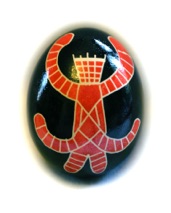
At the start of the rule of Volodymyr the Great the idols of the chief gods—Perun, Khors, Dazhboh, Stryboh, Symarhl, and Mokosh—stood on a hill near his palace. Plant, animal, and occasionally human sacrifices were brought before them. Upon adopting Christianity he destroyed the idols and built Saint Basil's Church at the site. Most of the common people continued to worship the pagan deities (see Mythology) and nature and household spirits (see Demonology).
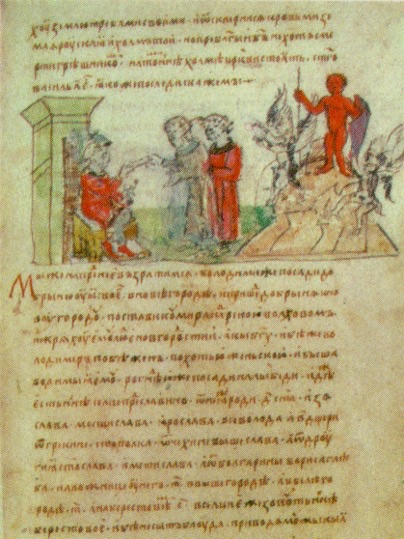
Grand Prince Volodymyr and his pantheon of pagan gods (an illumination from the Rus' Chronicle)
The pagans did not build special shrines but worshiped in the open at altars on sacred sites. According to a Greek chronicler of the 10th century an altar was built under a great oak on Khortytsia Island, and Kyiv merchants sailing down the Dnipro River stopped to offer sacrifice there. Vikentii Khvoika excavated a site with a large sacrificial altar in Kyiv. Sacred sites of the first few centuries AD were found on vestal hills on the Dnipro River, near the village of Trypilia, and on the Ros River, near Sakhnivka (see Sakhnivka settlements). There were also several such sites on so-called Bald hills in Ukraine. In the Christian era these locales were believed to be the gathering places of witches and sorceresses. The pagans did not have a separate priestly caste, only soothsayers, known as volkhvy. Sacrifices on behalf of particular persons were brought by the persons themselves or their relatives; those for the benefit of a family, by the family head; and those for the country's sake, by the kniaz (prince).
Pagans in Ukraine believed in the afterlife and viewed it as an extension of this life. According to foreign writers they preferred death to captivity out of the fear of remaining slaves after death. They were buried with their favorite objects and with symbols of their social status. The dead were usually buried, but some were cremated. Funerals involved various rituals and songs. (See Burial rites and Laments.) A year after a funeral a commemorative banquet was held. Weddings also were highly ritualized. Paganism tolerated polygamy, although most people, particularly the lower classes, practiced monogamy.
The Christian church actively opposed paganism. It supplanted the more popular cults with Christian ones: Perun with Saint Elijah, Veles with Saint George, Kupalo with Saint John the Baptist. The seasonal agricultural festivals were also modified and associated with Christian holidays: the winter equinox became Christmas, the ‘Great Day’ (Velykden’) became Easter, and the Rosalia / Zeleni Svyata became the Descent of the Holy Spirit. Each of these festivals retains to this day elements of pagan rites. Gradually the church introduced its sacraments into everyday life – first into baptism and burial, then, finally, into marriage. Some pagan folk customs (caroling, the blessing of wells and fields) that could not be suppressed were simply adopted by the church. The expected result, however, was not always achieved: in most cases, Christian and pagan rituals with the same function were practiced side by side. Other pagan customs, such as the harvest rituals, were converted from religious into folkloric practices. Soothsaying was incorporated into the games of Saint Andrew's Eve.
The people often interpreted church holidays in pagan terms; the Virgin Mary's Presentation at the Temple, for example, was viewed as a festival of the dead in Ukraine (the dead were said to ‘see’ their bodies on this day), and Christ's Presentation at the Temple celebrated the encounter between winter and spring. Traces of paganism were preserved longest in various seasonal folk customs and rites, such as the Christmas Eve dinner, carols, the Easter vesnianky-hahilky, the transfer of livestock to the pasture in the springtime, the Kupalo festival, the harvest rituals, and pomynky (Calendric ritual folk poetry). A number of pagan rites have been retained in the wedding ceremonies. The oldest forms of the Ukrainian folk oral literature, including tales, legends, and aphorisms, originated in the pagan era.
Principle Deities
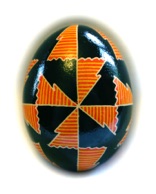
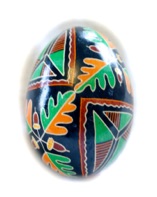
Khors/Хорс. In Slavic mythology a god of the sun and the source of righteousness. According to the Primary Chronicle, an idol to Khors was located near the palace of Volodymyr the Great in Kyiv. He is also mentioned in Slovo o polku Ihorevi. In the apocryphal Khozhdeniia Bohorodytsi po mukakh (see Apocryphal literature) and other later sources he is sometimes referred to as Velykyi Khors (the Great Khors). Some scholars believe that Khors is of Iranian origin.
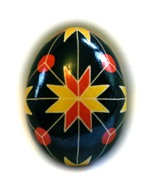
Stryboh/Стрибог. The pagan god of the wind, one of the chief gods worshiped by early Ukrainians and other Eastern Slavs. He was the counterpart of the Greek god Aeolus. Stryboh is mentioned in early monuments of Ukrainian literature, including the Primary Chronicle and Slovo o polku Ihorevi (The Tale of Ihor's Campaign). The cult of Stryboh left many traces in Ukrainian toponymy—the village of Strybizh, in the Zhytomyr region, for example, and the Strybizka River, in the Kyiv region. There are different theories concerning the etymology of the name Stryboh. It may have come from strybaty ‘to leap’ or from sterty ‘to erase.’ Some scholars contend that the first syllable (stry-) shares a common root with the universal Slavic word strila or strika ‘arrow’, which relationship suggests that an ancient poetic trope comparing the wind to an arrow may be reflected here.
Veles/Велес (aka Volos). The old Slavic god of cattle, wealth, and trade. He was one of the chief deities in the pantheon of pagan Rus’. In concluding treaties with the Byzantines (see Byzantine Empire) the Kyivan princes swore an oath to Perun and Veles. With the adoption of Christianity Saint Vlas (Vlasii) replaced Veles as the protector of livestock.
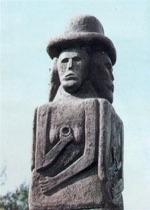
Back to MAIN Symbolism home page.
Back to MAIN Pysanka home page.
Back to Pysanka Index.
Search my site with Google
Swastika = Svaroh
Oak tree = Perun
Sun/Star = Dazhboh
Berehynia from Volyn’